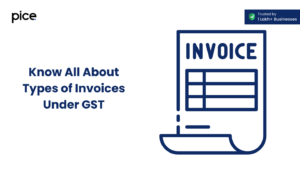GST Due Dates and Penalty Charges
- 5 Sep 24
- 12 mins

GST Due Dates and Penalty Charges
Key Takeaways
- GST simplifies India's tax structure with classified slabs ensuring compliance.
- Filing GST returns on time allows vendors to optimize Input Tax Credit (ITC).
- GST returns include details of income, sales, expenses, and purchases for tax liability.
- There are 11 active types of GST returns, each with specific filing deadlines.
- Late GST payments incur daily penalties, with maximum caps based on return type.
The introduction of Goods and Services Tax (GST) in 2017 has simplified the complex structure of State and Central taxes. Its classified tax slabs ensure strong compliance with tax payments, benefitting nationwide commercial enterprises. Non-filing GSTR results in cascading consequences, from hefty penalties to operational disruptions.
Filing GST returns within the given time limit allows vendors to avail and optimise ITC to offset output tax liability. To help you comprehend the basics, this comprehensive overview walks you through the GST payment due date, types of GST returns, filing procedures, penalties and more.
What Is a GST Return?
Simply put, a GST return is a record that every registered taxpayer must submit. It requires information about income, sales, expenses and purchases. This document aims to help tax administrations to determine the net tax liability.
As per the GST provisions, normal dealers must consider filing GST returns that include:
- Purchases
- Sales
- Output GST (On deals)
- Input tax credit (GST paid on acquisitions)
How Many Types of Returns Are There Under GST?
Though there are 22 different types of GST returns, only 11 types are currently active. The rest are either suspended or articulated under the view-only mode. This total number of active GST returns and their types rely on taxpayers' specifications. There are 7 types of taxpayers, such as:
- Regular taxpayers
- E-commerce operators
- Composition taxable persons
- TDS deductors
- Input Service Distributors (ISDs)
- Non-resident taxpayers
- Casual taxable persons
💡 If you want to pay your GST with Credit Card, then download Pice Business Payment App. Pice is the one stop app for all paying all your business expenses.
Different Types of GST Returns and Their Filing Deadlines
The GST payment due date varies according to the type of return. The following are the active GST returns along with their filing deadlines. Take a look:
- GSTR-1
GSTR 1 comprises outward supply details of all goods and services. Thus, filing this requires sales invoices and debit/credit notes of that particular financial year. Registered suppliers must report any changes made to sales invoices, including those from previous tax periods, in the GSTR-1.
Due dates for GSTR 1 filing:
- Monthly: 11th of the upcoming month for regular taxpayers.
- Quarterly: 13th of the succeeding month of the quarterly GSTR-1 payment. Taxpayers must be enrolled under the QRMP scheme to avail this.
2. GSTR-3B
GSTR-3B is a monthly self-declaration summary return for taxpayers. It summarises information on all outward supplies, input tax credit claims, tax liability and tax invoices. Before filing GSTR-3B, ensure to match sales and input tax credit details in filed GSTR-1 and auto-drafted return of GSTR-2B for each tax period. Any discrepancies found by the tax authorities can potentially result in the suspension of GST registration.
Due dates for GSTR 3B returns filing:
- Monthly: Businesses with an annual turnover of more than ₹5 crore in the previous financial year must file this monthly return by the 20th of the following month.
- Quarterly:
- For states in category 'X', such as Chhattisgarh, Madhya Pradesh, Gujarat, Maharashtra, Tamil Nadu, Telangana, Andhra Pradesh, Andaman and Nicobar Islands, Daman and Diu and Dadra and Nagar Haveli and more, the quarterly basis due date is the 22nd of the month succeeding the quarter.
- For states in the category 'Y', such as Himachal Pradesh, Punjab, Rajasthan, Uttar Pradesh, Arunachal Pradesh, Nagaland, Assam, West Bengal, Jharkhand, and more, this quarterly return must be filed within the 24th of the month following the quarter. This applies to taxpayers with aggregate turnover equal to or below ₹5 crore.
- CMP-08
CMP-08 is a statement-cum-challan with details of self-assessed tax payable for the particular quarter. The filing of returns in form CMP-08 also serves as a challan per tax period for payment. It is ideal for composition dealers with aggregate turnover between ₹1 crore and ₹1.5 crores.
Due dates for CMP-08 filing:
- Being one of the quarterly filers, it must be filed on or before the 18th of the following month of the quarter.
- GSTR-4
GSTR-4 return is for composition scheme dealers. This annual return keeps a note of all transaction returns. It comprises details of all supplies, sales and paid compound tax during the tax period.
Due dates for filing GSTR-4:
- Taxpayers must file within 30th April of the succeeding fiscal year.
- GSTR-5
This return is for non-resident foreign taxpayers. This form features details of taxable supplies, both inward and outward, tax paid, tax liability, and credit and debit notes.
The due date for filing GSTR-5:
- Since it is a monthly return, the time period for filing it is the 20th of every month.
- GSTR-5A
GSTR-5A is exclusively tailored for non-resident Online Information and Database Access or Retrieval (OIDAR) services providers. It applies to offered services from outside India to non-taxable Indian customers.
The due date for filing GSTR-5A:
- Taxpayers can file it by the 20th of each month. Post that late fee will apply.
- GSTR-6
The monthly return GSTR 6 caters to an Input Service Distributor. It includes information about the eligible input tax credit and its distribution.
The due date for filing GSTR 6:
- Input Service Distributors should process this monthly payment of taxes within the 13th of the subsequent month.
- GSTR-7
GSTR-7 is a mandatory monthly return for individuals who are obligated to deduct TDS (Tax Deducted at Source) under GST. The form must furnish comprehensive details of the TDS deducted, the TDS liability that is payable and paid, and the claimed TDS refund using the GST refund applications, if any.
The payment due date for this GSTR is:
- One can file this by the 10th of the upcoming month.
- GSTR-8
GSTR-8 is a return for e-commerce operators. It helps to deduct TCS (Tax Collected at Source) under GST. It incorporates details of supplies using e-commerce platforms and the total amount of TCS collected on them.
The due date for filing:
- E-commerce operators must process the filing by the 10th of the next month.
- GSTR-9 and Self-Certified GSTR-9C
GSTR 6 is an annual return. It is a consolidated return of other GST fillings including GSTR 1, GSTR 2A, and GSTR 3B. Registered sellers must file this by inputting details of inward supplies, outward supplies, and taxes, both payable and paid.
GSTR 9C, on the other hand, is a mandatory self-certified reconciliation statement. Every registered person under GST with an annual turnover of more than ₹5 crore during a financial year needs to file this form.
The due date for these GST return filings:
- 31st December of the following relevant fiscal year.
How Are GST Returns Filed or Submitted?
Filing GST returns has become quite simple nowadays. You can file returns either online through the official website of Goods and Service Taxes or via the offline tool. Registered taxpayers can also utilise the Goods and Services Tax Network (GSTN) software to file returns with ease.
Here is how you can submit error-free GST filings online:
Step 1: Go to the official GST portal.
Step 2: Navigate to the right side top to find ‘Register’. Click on it to create your unique GSTIN using your state code and PAN number.
Step 3: You have to log in using your credentials after registration.
Step 4: Go to ‘Services’ and select ‘Returns Dashboard’ from the dropdown. Here, you have to pick the financial year for which you are willing to file GSTR.
Step 5: In this step, you can select the return you prefer to raise. This step also gives you a choice on how you wish to proceed. Click on ‘Prepare Online’ for digital filing.
Step 6: All invoices must be uploaded here. Once uploaded, you will receive a unique reference number. After that, taxpayers are eligible to file returns for outward supplies, inward supplies as well as cumulative monthly returns.
Step 7: Once you enter all the relevant details, you must save the form before submitting it.
Step 8: Post-submission, make sure to check the status of your GST returns, it should be changed to ‘Submitted’.
Step 9: Next, click on ‘Payment of Tax’ to complete the transaction. Clicking on the ‘Check Balance’ option discloses the cash and credit balance in the electronic cash ledger of the taxpayer.
Step 10: Navigate to ‘Offset Liability’ > ‘File Form with DSC’/’File Form with EVC’ to pay taxes through digital mode. Ensure to tick the declaration boxes before making the payment.
Please note: There are various GST return forms to choose from, and each form may require more or fewer steps than the standard process described earlier. The official GST website provides information on how to complete these forms. It is important to have all the necessary details on hand before filling out any GST form. Moreover, if you have claimed an Input Tax Credit on Goods and Services, the return will be saved in the electronic credit ledger. It can only be used for tax payments.
The Good and Services Tax department has tailored an offline tool to file GST returns. Here is how you can access it:
Step 1: Go to the common portal of Goods and Services Tax and navigate to ‘Downloads’ > ‘Offline Tools’.
Step 2: This offline tool is a zip file containing the GST Offline tool (application), section-wise CSV files, GSTR1 and GSTR2 Excel Workbook Template and user manual.
Step 3: Go through the user manual in detail to clearly understand the process.
Step 4: Proceed with the installation by clicking on ‘GST Offline Tool’.
Is GST Payment Required Monthly?
Regular dealers can pay GST returns monthly. Taxpayers who opted for the QRMP scheme have a choice of filing their returns either monthly or quarterly.
However, vendors who do not prefer monthly payments of taxes and small taxpayers can consider availing the composition scheme under GST. To enrol under this scheme, annual aggregate turnover must be less than ₹5 crore. Composite dealers can process a filing statement-cum-challan to pay taxes quarterly.
Please note certain GST forms, like GSTR-4, support annual returns. In such a case, to file a 2023-24 annual return, taxpayers should submit the form within the due date of the 2024-25 calendar.
Late Payment Interest & Fees for GST

Based on the GST provisions, late filing returns incur penalties. Several factors play key roles in determining the cost of late fees and penalties. It is crucial to understand these factors clearly. Here is a thorough breakdown:
- Daily Charge: As the name implies, this fee serves for each day of delayed return. The amount of this factor varies as per different GST returns. It is counted every day until the return is filed, massively increasing the overall penalty.
- Maximum Cap: To save enterprises from high penalties, the government has imposed a maximum cap. It aims to keep the penalties proportionate compared to the total payable tax.
- Type of Return: The type of return you are filing also signifies the penalty amount for late payment. Different forms have various rates.
Here is a tabulated illustration for improved understanding:
| Return name | Return type | Annual turnover in the previous FY | Daily late fee | Maximum late fee |
| GSTR 1 and 3B | Nil | NA | ₹20 | ₹500 |
| Others | Up to ₹1.5 crore | ₹50 | ₹2,000 | |
| From ₹1.5 crore to ₹5 crore | ₹5,000 | |||
| More than ₹5 crore | ₹10,000 | |||
| GSTR 4 (from FY 21-22) | Nil | NA | ₹20 | ₹500 |
| Others | NA | ₹50 | ₹2,000 | |
| CMP-08 | NA | NA | ₹200 | ₹5,000 |
| GSTR 5 | Nil | NA | ₹20 | ₹5,,000 |
| Others | ₹50 | |||
| GSTR 5A | Nil | NA | ₹100 | NA |
| Others | ₹200 | |||
| GSTR 6 | Nil | NA | ₹50 | NA |
| Others | ||||
| GSTR 7 | Nil | NA | ₹200 | ₹5,000 |
| Others | ||||
| GSTR 8 | Nil | NA | ₹200 | ₹5,000 |
| Others | ||||
| GSTR 9 / GSTR 9C | Nil | NA | ₹200 | 0.50% of the annual turnover |
| Others |
Final Word
Hopefully, this all-inclusive guide to the GST payment due date will cater to all your needs. Irrespective of the type of business, vendors must adhere to the prescribed norms and file GST within the stipulated date to reduce the burden and keep track of their sales. Registered taxpayers are subject to file monthly/annual returns depending on their types of businesses.
 By
By 
















